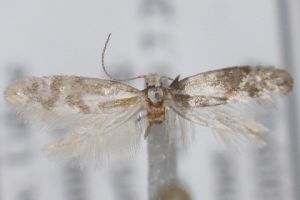

 +1Kontinente:EU
+1Kontinente:EU2. Diagnose
2.1. Falter
3. Biologie
3.1. Nahrung der Raupe
Noch unbekannt! Wahrscheinlich aber Wacholder Juniperus sp. Huemer (2010) erläutert zur Biologie der Art: "Argyresthia friulii sp. n. occurs on the northern slopes of Monte Canin in north-eastern Italy. The typelocality is a karstified, dolomitic high plateau with scarce and largely fragmented vegetation. The habitat of the new species however, benefits from a predominantly southern exposition and coverage of alpine plants is higher than in the surroundings. The adults have been collected during the day time but no notes have been taken about the microhabitat and nothing is known about the preimaginal stages of the new species and its ecological niche. Related species such as A. abdominalis or several European taxa of the subgenus Blastotere feed on Cupressaceae and/or Pinaceae. Several of these taxa are related to Juniperus and feed either in the fruits or needles. Most probably Juniperus is also the natural hostplant of A. friulii sp. n."
(Autor: Erwin Rennwald)
4. Weitere Informationen
4.1. Faunistik
Huemer (2010) beschrieb die Art nach 12 Exemplaren von einem einzigen Fundort und notierte zur Verbreitung: "At present A. friulii sp. n. is only known from the north-eastern Alps of Italy (Friuli Venezia Giulia, Prov. Udine, Mte. Canin)."
4.2. Typenmaterial
Huemer (2010) sammelte alle 12 Exemplare der Typenserie an einem Ort und an einem Tag:
"Material. Holotype ♂: “Italia, Prov. Udine, Monte Canin N, Rif. Gilberti Umg., 1850-1950 m, 29.7.2001 leg. Huemer, TLMF 2009-017 (TLMF)”.
Paratypes. Italy: 9 ♂♂, 2 ♀♀, same data as holotype, gen. slides YPO 143f , YPO 145 m (MFSN; TLMF) [4 ♂♂, 1 ♀ without abdomen]."
4.3. Literatur
- Erstbeschreibung: Huemer, P. (2010): Argyresthia friulii sp. n., a new species from the Julian Pre-Alps, Northern Italy (Lepidoptera, Yponomeutidae). — Gortania 31: 173-141. Udine [PDF auf civicimuseiudine.it]




